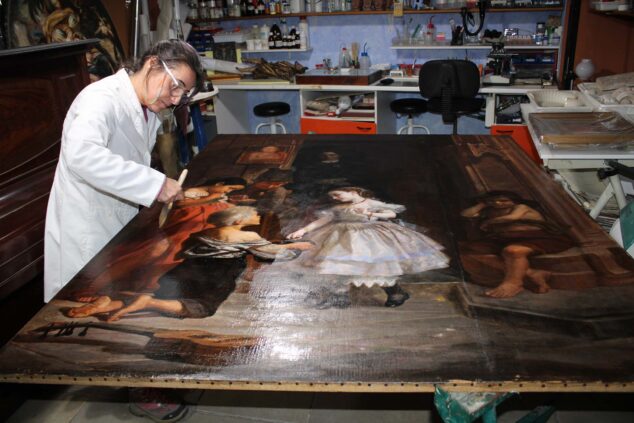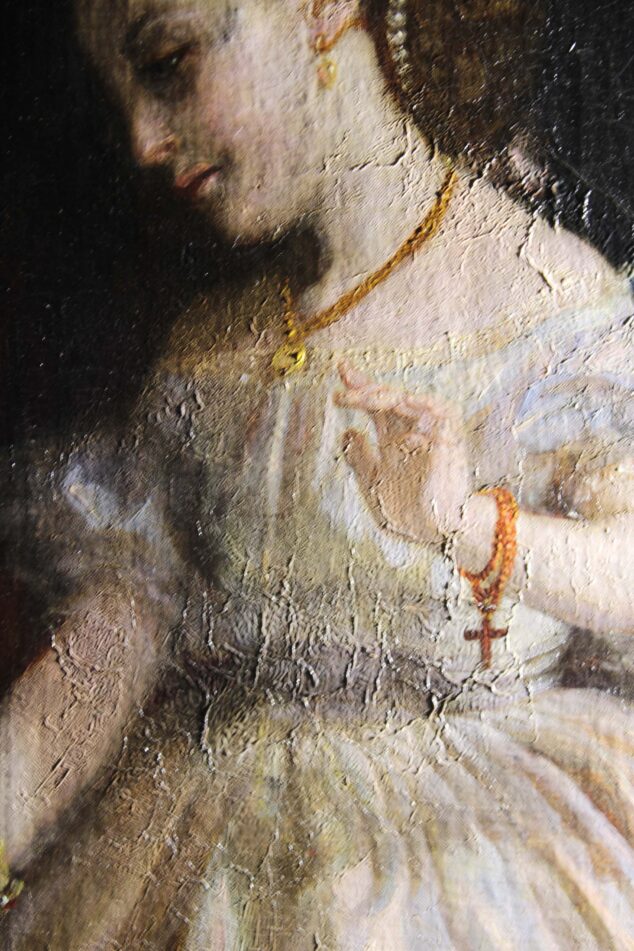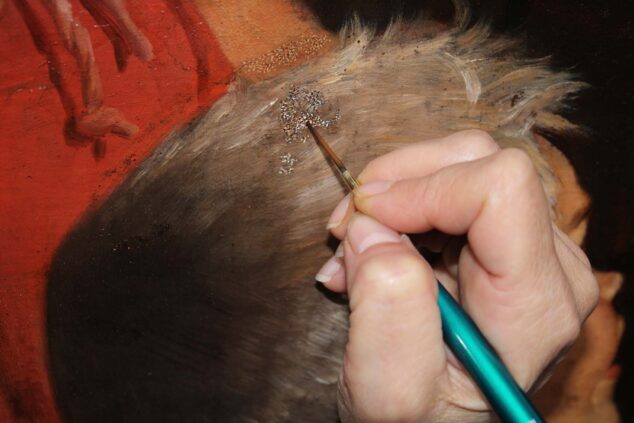The work The Caritat by Domingo Llorens Cervera is already on display to the public today on the ground floor of the Ethnology Museum of Dénia after a thorough restoration process that has returned the Deniera painting to its original splendor. The Caritat It will be available for your visit every day of the week from 10:00 a.m. to 13:00 p.m.
In addition, the Archeology and Museums area has scheduled two guided tours for the coming weeks, offering a unique opportunity to get closer to the work, the artist and his era, as well as the restoration process that allows its optimal visualization and conservation. These visits will take place on Wednesday, December 27, 2023 and Wednesday, January 3, 2024, at 12 noon. The prior registration required to participate can be done, from Monday to Sunday, from 10 a.m. to 13 p.m., by calling 96 642 02 60.
The Caritat arrived at the Ethnological Museum in March 2018. After a process of location and contact, the bidding at auction and the acquisition of the oil painting were carried out. The Caritat by the painter Domingo Llorens Cervera, a fundamental work in the painter's career. The work of art was donated by the Dénia Sports Foundation to the Dénia City Council, conditional on permanent public exhibition.
Origin and description of La Caritat
The painting is an oil on canvas with the signature in the lower left corner. It presents a popular theme among the bourgeoisie of the XNUMXth century: the poor and charity towards that class of people, according to Massu. Sentí, head of the Archeology and Museums area.
In a letter dated 1856 to Bernardo López, son of the teacher Vicente López, Domingo Llorens Cervera mentions that he is working in a group of poor people, without a doubt The Caritat. Bernardo López was also explicit in his response: I am glad that you work so hard and I would like to see that painting of poor people that he tells me he is creating, because the idea is very good and partisan; You will have already ensured that it has a good color without glare and firmness of light and dark.
The painting that Domingo Llorens Cervera refers to is, indeed, The Caritat, which the painter would present at the Valencia Regional Exhibition in 1867, where he won the silver medal. "Llorens' oil painting is an allegory, in the strict moralizing sense, of Charity as a virtue, in this case, represented more in a narrative than symbolic way," he states. Sentí.
The painting presents a scene located at the door of a church where in the middle stands the main character, a girl, who exercises charity under the pleased gaze of the person who accompanies her, a woman in dark clothing. On this image, dressed in bluish white, she directs and concentrates all the light in the painting. She is a richly dressed character, with clothes, jewelry, footwear and hairstyle that stand out for the exhaustive nature of the author's detail. The main character extends his hand to offer a coin, to distribute alms, to a kneeling, barefoot and poorly dressed child, under the attentive gaze of three others of similar condition. Hanging on the door of the church, a painting shows a soul from purgatory with the legend OY SE CAMA ALMA, "perhaps to record that the sacrifices made, such as the exercise of charity, can help the souls in purgatory to achieve his salvation," he evaluates Sentí.
Restoration and technique
The Caritat by Domingo Llorens Cervera was in a very poor state of conservation with main pathologies resulting from old interventions, repainting and revernizing; pictorial film with wrinkles caused by the contraction of the varnish layers; general dirt and stains; degraded textile support with a very acidic pH, and, finally, biological attacks.
The work has been carried out with a scientific methodology and following a museum criterion of minimal intervention, according to which only the necessary processes have been carried out to resolve the pathologies that affect the work and guarantee its conservation over time.
«The reintegrations are of great artistic quality, with excellent execution. This is why the criterion has been followed of eliminating only poorly applied reintegrations that altered the reading of the work or could cause mechanical damage to the pictorial surface. The periodic review of the work will guarantee the prevention of pathologies and will allow for good conservation," explains the head of the Archeology and Museums area.
The team responsible for the restoration has been Lorena Morillas Bono and José L. Pascual Hidalgo from the Bocairent Art and Restoration Workshop, with a long and reputable history of interventions in works of art, both movable and immovable, with complex projects such as the rehabilitation of churches or palaces. The works have been promoted by the Ethnological Museum with contribution from the General Directorate of Heritage.
Domingo Llorens Cervera: life and work
Little is known about Domingo Llorens Cervera, the painter Llorens. He is a character who, unfortunately, is awaiting study and documentation, as well as cataloging of his very dispersed work, a circumstance that makes achieving the objective difficult. The painter was born in Dénia on February 10, 1827, although this date depends on the source consulted. Domingo Llorens was lucky enough to train in Valencia, from where he would enter the circle of the painter Vicente López. After the death of the master, Domingo Llorens would return to the city in which he was born, becoming the careful painter of the bourgeoisie of the 8th century. Domingo Llorens died in Dénia on May 1905, XNUMX.









